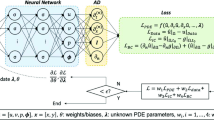Abstract
When modeling physical processes in spatially confined domains, the boundaries require distinct consideration through specifying appropriate boundary conditions (BCs). The finite volume neural network (FINN) is an exception among recent physics-aware neural network models: it allows the specification of arbitrary BCs. FINN is even able to generalize to modified BCs not seen during training, but requires them to be known during prediction. However, so far even FINN was not able to handle unknown BC values. Here, we extend FINN in order to infer BC values on-the-fly. This allows us to apply FINN in situations, where the BC values, such as the inflow rate of fluid into a simulated medium, is unknown. Experiments validate FINN’s ability to not only infer the correct values, but also to model the approximated Burgers’ and Allen-Cahn equations with higher accuracy compared to competitive pure ML and physics-aware ML models. Moreover, FINN generalizes well beyond the BC value range encountered during training, even when trained on only one fixed set of BC values. Our findings emphasize FINN’s ability to reveal unknown relationships from data, thus offering itself as a process-explaining system.
This work was partially funded by German Research Foundation (DFG) under Germany’s Excellence Strategy - EXC 2075 - 390740016 as well as EXC 2064 - 390727645. We acknowledge the support by the Stuttgart Center for Simulation Science (SimTech). Moreover, we thank the International Max Planck Research School for Intelligent Systems (IMPRS-IS) for supporting Matthias Karlbauer.
Access this chapter
Tax calculation will be finalised at checkout
Purchases are for personal use only
Similar content being viewed by others
References
Battaglia, P.W., et al.: Relational inductive biases, deep learning, and graph networks. arXiv preprint arXiv:1806.01261 (2018)
Butz, M.V., Bilkey, D., Humaidan, D., Knott, A., Otte, S.: Learning, planning, and control in a monolithic neural event inference architecture. Neural Netw. 117, 135–144 (2019)
Chen, R.T.Q., Rubanova, Y., Bettencourt, J., Duvenaud, D.: Neural ordinary differential equations (2019)
Fletcher, C.A.: Generating exact solutions of the two-dimensional burgers’ equations. Int. J. Numer. Meth. Fluids 3, 213–216 (1983)
Guen, V.L., Thome, N.: Disentangling physical dynamics from unknown factors for unsupervised video prediction. In: Proceedings of the IEEE/CVF Conference on Computer Vision and Pattern Recognition, pp. 11474–11484 (2020)
Karlbauer, M., Otte, S., Lensch, H.P., Scholten, T., Wulfmeyer, V., Butz, M.V.: A distributed neural network architecture for robust non-linear spatio-temporal prediction. In: 28th European Symposium on Artificial Neural Networks (ESANN), Bruges, Belgium, pp. 303–308, October 2020
Karlbauer, M., Praditia, T., Otte, S., Oladyshkin, S., Nowak, W., Butz, M.V.: Composing partial differential equations with physics-aware neural networks. In: International Conference on Machine Learning (ICML) (2022)
Karniadakis, G.E., Kevrekidis, I.G., Lu, L., Perdikaris, P., Wang, S., Yang, L.: Physics-informed machine learning. Nat. Rev. Phys. 3(6), 422–440 (2021)
Li, Z., et al.: Fourier neural operator for parametric partial differential equations. arXiv preprint arXiv:2010.08895 (2020)
Long, Z., Lu, Y., Ma, X., Dong, B.: PDE-net: learning PDEs from data. In: International Conference on Machine Learning, pp. 3208–3216. PMLR (2018)
Moukalled, F., Mangani, L., Darwish, M.: The Finite Volume Method in Computational Fluid Dynamics: An Advanced Introduction with OpenFOAM and Matlab. FMIA, vol. 113. Springer, Cham (2016). https://doi.org/10.1007/978-3-319-16874-6
Naugolnykh, K.A., Ostrovsky, L.A., Sapozhnikov, O.A., Hamilton, M.F.: Nonlinear wave processes in acoustics (2000)
Otte, S., Karlbauer, M., Butz, M.V.: Active tuning. arXiv preprint arXiv:2010.03958 (2020)
Praditia, T., Karlbauer, M., Otte, S., Oladyshkin, S., Butz, M.V., Nowak, W.: Finite volume neural network: modeling subsurface contaminant transport. In: International Conference on Learning Representations (ICRL) - Workshop Deep Learning for Simulation (2021)
Raissi, M., Perdikaris, P., Karniadakis, G.E.: Physics-informed neural networks: a deep learning framework for solving forward and inverse problems involving nonlinear partial differential equations. J. Comput. Phys. 378, 686–707 (2019)
Sculley, D., et al.: Hidden technical debt in machine learning systems. In: Proceedings of the 28th International Conference on Neural Information Processing Systems - Volume 2, NIPS 2015, pp. 2503–2511. MIT Press, Cambridge (2015)
Seo, S., Meng, C., Liu, Y.: Physics-aware difference graph networks for sparsely-observed dynamics. In: International Conference on Learning Representations (2019)
Sitzmann, V., Martel, J., Bergman, A., Lindell, D., Wetzstein, G.: Implicit neural representations with periodic activation functions. Adv. Neural. Inf. Process. Syst. 33, 7462–7473 (2020)
Yin, Y., et al.: Augmenting physical models with deep networks for complex dynamics forecasting. J. Stat. Mech: Theory Exp. 2021(12), 124012 (2021)
Author information
Authors and Affiliations
Corresponding author
Editor information
Editors and Affiliations
Rights and permissions
Copyright information
© 2022 The Author(s), under exclusive license to Springer Nature Switzerland AG
About this paper
Cite this paper
Horuz, C.C. et al. (2022). Infering Boundary Conditions in Finite Volume Neural Networks. In: Pimenidis, E., Angelov, P., Jayne, C., Papaleonidas, A., Aydin, M. (eds) Artificial Neural Networks and Machine Learning – ICANN 2022. ICANN 2022. Lecture Notes in Computer Science, vol 13529. Springer, Cham. https://doi.org/10.1007/978-3-031-15919-0_45
Download citation
DOI: https://doi.org/10.1007/978-3-031-15919-0_45
Published:
Publisher Name: Springer, Cham
Print ISBN: 978-3-031-15918-3
Online ISBN: 978-3-031-15919-0
eBook Packages: Computer ScienceComputer Science (R0)




